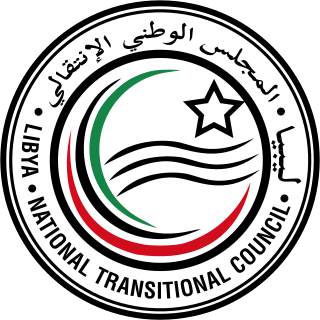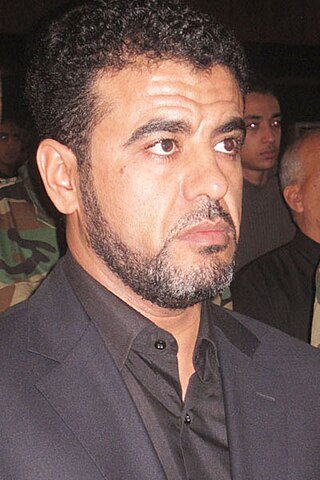
Saif al-Islam Muammar al-Gaddafi is a Libyan political figure. He is the second son of the late Libyan leader Muammar Gaddafi and his second wife Safia Farkash. He was a part of his father's inner circle, performing public relations and diplomatic roles on his behalf. He publicly turned down his father's offer of the country's second highest post and held no official government position. According to United States Department of State officials in Tripoli, during his father's reign, he was the second most widely recognized person in Libya, being at times the de facto prime minister, and was mentioned as a possible successor, though he rejected this. An arrest warrant was issued for him on 27 June 2011 by the International Criminal Court (ICC) for charges of crimes against humanity against the Libyan people, for killing and persecuting civilians, under Articles 7(1)(a) and 7(1)(h) of the Rome statute. He denied the charges.

The National Liberation Army, officially the National Liberation Armed Forces of the Free Libyan Republic, formerly known as the Free Libyan Army, was a Libyan military organisation affiliated with the National Transitional Council, which was constituted during the First Libyan Civil War by defected military members and civilian volunteers, in order to engage in battle against both remaining members of the Libyan Armed Forces and paramilitia loyal to the rule of Muammar Gaddafi. Its self proclaimed chief commander was General Khalifa Haftar, although the National Transitional Council preferred to appoint Major General Abdul Fatah Younes Al-Obeidi as its commander-in-chief. It had prepared for some time in portions of Eastern Libya controlled by the anti-Gaddafi forces for eventual full-on combat in Western Libya against pro-Gaddafi militants, training many men before beginning to go on the offensive. They have battled for control of Benghazi, Misrata, Brega, Ajdabiya, Zawiya and Ra's Lanuf as well as several towns in the Nafusa Mountains. They finally began the Battle for Tripoli in August 2011 when they attacked from the west of the city, as well as fomenting an internal uprising on 20 August.

The timeline of the Libyan civil war begins on 15 February 2011 and ends on 20 October 2011. The conflict began with a series of peaceful protests, similar to others of the Arab Spring, later becoming a full-scale civil war between the forces loyal to Muammar Gaddafi's government and the anti-Gaddafi forces. The conflict can roughly be divided into two periods before and after external military intervention authorized by United Nations Security Council Resolution 1973.

The Tripoli Revolutionaries Brigade or Free Tripoli Guardian was a unit of the National Liberation Army of Libya created during the Libyan Civil War that merged into the Tripoli Protection Force. Originally formed in April 2011 in the opposition stronghold of Benghazi, it later relocated to the Nafusa Mountains, then the closest frontline to Tripoli, before advancing into the city itself in August.

The Libyan Civil War began on 15 February 2011 as a civil protest and later evolved into a widespread uprising. However, by 19 March, Libyan forces under Colonel Muammar Gaddafi were on the brink of a decisive victory over rebels in Libya's east. That day, leading NATO members acted on United Nations Security Council Resolution 1973 which authorized member states "to take all necessary measures... to protect civilians and civilian populated areas under threat of attack in the Libyan Arab Jamahiriya, including Benghazi, while excluding an occupation force".

The aftermath of the 2011 Libyan civil war has been characterized by marked change in the social and political order of Libya after the overthrow and killing of Muammar Gaddafi in the civil war that was fought in Libya in 2011. The country has been subject to ongoing proliferation of weapons, Islamic insurgencies, sectarian violence, and lawlessness, with spillovers affecting neighboring countries including Mali.

Major General Osama al-Juwaili is a Libyan military officer who served as Minister of Defence in the government of Abdurrahim El-Keib, Libya's interim Prime Minister. Since the formation of the Government of National Accord (GNA) in 2015, al-Juwaili served it as a senior commander, since 2017 being the commander of the Western Military Zone. On 6 April 2019 he became the commander of the joint operations room, created by Prime Minister Fayez al-Sarraj to coordinate military operations since the start of the 2019 Western Libya offensive.

Following the end of the First Libyan Civil War, which overthrew Muammar Gaddafi, there was violence involving various militias and the new state security forces. This violence has escalated into the Second Libyan Civil War (2014–2020).

Abdullah Naker is the head of the Tripoli Revolutionist Council (TRC).

The Libyan Army is the brand for a number of separate military forces in Libya, which were under the command of the internationally recognised Government of National Accord (GNA) and the Government of National Unity.

The Libyan National Army or the Libyan Arab Army is a component of Libya's military forces which were nominally a unified national force under the command of Field Marshal Khalifa Haftar when he was nominated to the role on 2 March 2015 by the House of Representatives, consisting at the time of a ground force, an air force and a navy.

Gaddafi loyalism, in a wider political and social sense also known as the Green resistance, consists of sympathetic sentiment towards the overthrown government of Muammar Gaddafi, who was killed in October 2011, and his Third International Theory. Despite Muammar Gaddafi's death, his legacy and Jamahiriya ideology still maintains a popular appeal both inside and outside Libya into the present day. Regardless, the Western sentiment has largely been that this continued support may contribute to some of the ongoing violence in Libya.

The Libyan Special Forces (LSF), also known as the Al-Saiqa or Saiqa Special Forces and simply Saiqa or Al-Saiqa, are an elite Libyan National Army unit formed from a mixture of paratroopers, paramilitary forces and commandos. Prominent LSF commander Mahmoud al-Werfalli was indicted in 2017 and 2018 by the International Criminal Court for the war crime of murdering and ordering the murders of non-combatants, and was assassinated in 2021.

The Libyan civil war (2014–2020), also more commonly known as the Second Libyan Civil War, was a multilateral civil war which was fought in Libya between a number of armed groups, but mainly the House of Representatives (HoR) and the Government of National Accord, for six years from 2014 to 2020.

The Libya Shield Force is an armed organisation formed in 2012 out of anti-Gaddafi armed groups spread throughout Libya. The Libyan parliament designated much of the Libya Shield Force as terrorist and elements of the Libya Shield Force were identified as linked to al-Qaeda as early as 2012.

The Battle of Tripoli Airport was a major event that took place during the Second Libyan Civil War. It began on 13 July 2014 as part of a series of operations dubbed "Libya Dawn" or " فجر ليبيا" by a coalition of Islamist militias whom led a coup d'état operation against the House of Representatives (Libya) due to the 2014 Libyan parliamentary election and a series of operations to recapture the Airport and political institutions to wrest control over the capital of Tripoli. The battle ended in August 2014 with the capture of the Airport and ultimately its destruction. The battle was fought between an Islamist New General National Congress and the Zintani brigades.
The following lists events that happened in 2014 in Libya.

The Libyan Crisis is the current humanitarian crisis and political-military instability occurring in Libya, beginning with the Arab Spring protests of 2011, which led to two civil wars, foreign military intervention, and the ousting and death of Muammar Gaddafi. The first civil war's aftermath and proliferation of armed groups led to violence and instability across the country, which erupted into renewed civil war in 2014. The second war lasted until October 23, 2020, when all parties agreed to a permanent ceasefire and negotiations.
Clashes occurred in western Libya since 14 October 2016, when a coup d'état attempt was conducted by the former head of the National Salvation Government (GNS), Khalifa al-Ghawil, against Prime Minister Fayez al-Sarraj, the head of Libya's Government of National Accord (GNA). This evolved into fighting between the GNA and GNS for control of Tripoli and parts of western Libya, while pro-GNA militias also attacked other militias for control of the region.
The Misrata Military Council, also commonly referred to as the Misrata Brigades, or the Misrata Revolutionary Brigades, are armed units linked to the town of Misrata and its surrounding area, allied to, but separate from, the Libyan Army. They are the largest and strongest military unit in all of Libya, consisting of 40,000 fighters with over 200 battalions, making them the largest block of fighters. The Misrata Brigades played a large part in the Libyan Revolution, which overthrew Gaddafi, as well as the Second Libyan Civil War in which they fought the Libyan National Army as well as ISIL in Sirte.














